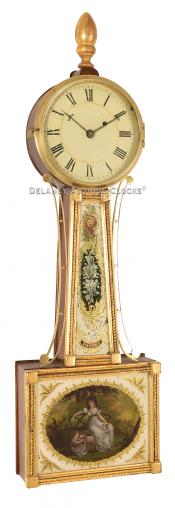Lemuel Curtis Wall Timepiece or Banjo Clock. Concord, Massachusetts. 221208.
This is a fine Federal Massachusetts timepiece or "Banjo clock" made in Concord, Massachusetts, circa 1820 by Lemuel Curtis.
This is an outstanding example. The case is constructed in mahogany and retains an older finish. A gilded wooden finial is mounted on a mahogany plinth at the top of the case above the dial. The dial is protected by glass fitted in a cast brass bezel. This bezel is hinged on the right and opens to access the dial. This dial is painted. A closed minute ring is positioned along the perimeter. Roman-style hour numerals mark each hour. A gilt band frames the inside of the hour display. The two hands are steel. They have been hand filed in the shape of arrows and display the time. The filing exhibits a high level of skill. These hands are three-dimensionally formed. The gracefully shaped brass side arms are fitted to the sides of the throat section. Both frames retain their original gilding. These are fitted with carved rope-style moldings, inset in the frame channels. These frames are fitted with reverse-painted tablets.
These tablets are original to this clock and are skillfully executed. The designs are complex and exhibit a high level of artistry that is nicely detailed. Gilding, reds, and greens are the predominant colors. The lower tablet depicts a woman dressed in a white gown and holding a book in her left hand. She is sitting on a bench at the edge of the lawn. A little girl is seated below her on the ground. The little girl, also dressed in white, is happily engaged with a small lamb. The scene is framed in a complex gilt oval-shaped border. The corners of the glass are decorated with gilt spandrels. The throat tablet is also colorfully paint-decorated. This features a traditional theme. It is signed "PATENT" in a red banner positioned in the lower section of the glass. The center section features a grape cluster and its' vine. This glass is cracked at the top.
Behind the dial is a brass movement that is weight-driven and is designed to run for approximately eight days fully wound. The plates are rectangular shaped. The front plate is die-stamped with the Maker's name just below the pendulum bridge. The movement is set in a Concord-style case having a very distinctive cutout in the head. It is mounted to the back of the case with a single screw. The bridge is a butterfly form, and the teeth in the gear train are deeply cut. The pendulum features a Concord-style keystone and a brass-faced bob. The tie-down is also the form of what one would expect to find in a clock made in Concord.
This clock measures approximately 33.25 inches long overall. This timepiece was made circa 1820.
Inventory number 221208.
Lemuel Curtis was born in Roxbury, Massachusetts, on July 3, 1790. He was the son of Samuel and Sarah (Partridge) Curtis, whose sister married Aaron Willard, making him his nephew. It is thought that Lemuel probably trained with Simon Willard in Roxbury. Lemuel had two brothers who were also involved with clockmaking. In 1811, he moved to Concord, MA, and took a shop near the Court House. At that time, Lemuel advertised that he was working on his own. On July 12, 1816, he was granted a patent for the girandole wall clock. This decorative form is considered by many to be America's most beautiful contribution to the market. Lemuel had two brothers who were also involved with clockmaking. His brother Benjamin Curtis may have painted a number of the glasses in his signed clocks. In 1820, he formed a partnership with Joseph N. Dunning. This partnership moved to Burlington, Vermont, in 1821. Their shop in Burlington was located at the corner of Church and College Streets in the Thomas Hotel. They worked there in collaboration until 1832. While in Burlington, they worked as clockmakers, silversmiths, and jewelers. Lemuel died in New York on June 17, 1857. Lemuel is known to have made girandoles, timepieces, lyre clocks, and shelf clocks.














